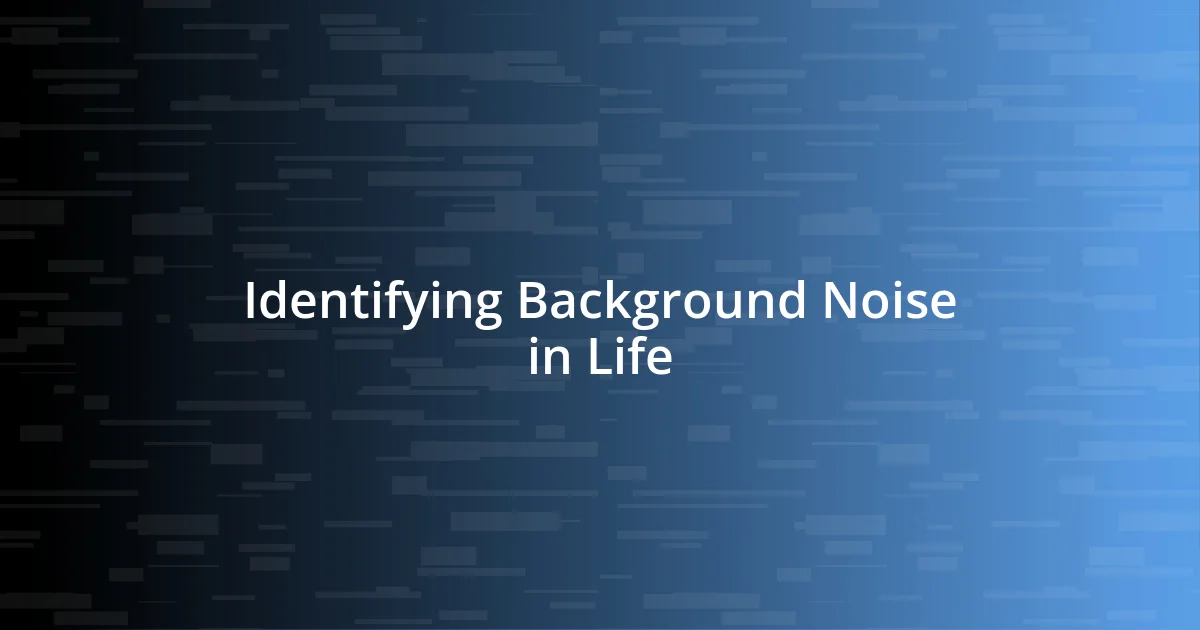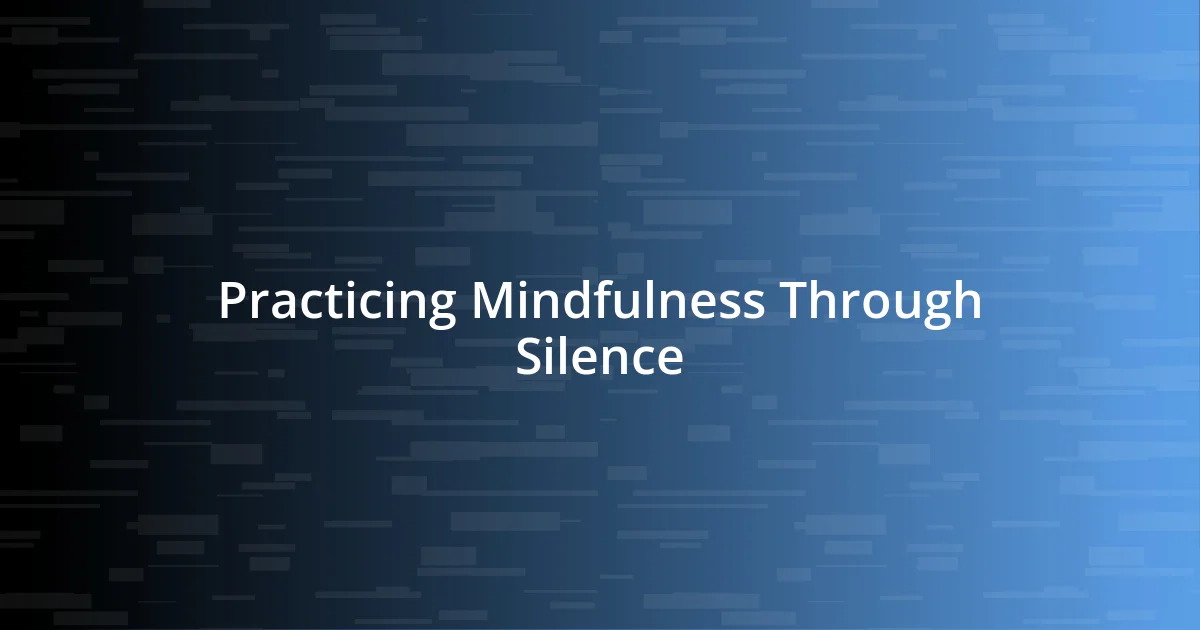Key takeaways:
- Silence helps gain clarity by allowing the mind to process thoughts and emotions, often leading to creative problem-solving and self-discovery.
- Identifying external and internal background noise is essential to reduce distractions and foster a deeper connection with oneself.
- Setting regular times for silence facilitates introspection and aids in transforming insights into actionable steps, promoting personal growth and accountability.

Understanding the Importance of Silence
Silence has an incredible way of cutting through the noise of our daily lives. I remember a time when I was overwhelmed by constant chatter—both internal and external. It was during a quiet afternoon at a park that I first realized how much clarity I could gain just by stopping to listen to the silence around me. Have you ever noticed how your mind begins to process thoughts and feelings more clearly when you remove distractions?
There’s a certain emotional release that comes with allowing silence into your life. I once took a weekend retreat where electronics were banned, and I found myself facing feelings I had long buried under the hustle. In that serene stillness, I began to confront and understand those emotions rather than run from them. Isn’t it astounding how silence can unveil the layers of our heart and mind?
On many occasions, I’ve found that embracing silence fosters creativity and problem-solving. When I was stuck on a difficult project, stepping away to sit in silence often led to the most innovative ideas bubbling up. Silence creates a mental space where our thoughts can roam freely, don’t you think? This unexpected clarity can be a powerful tool in both our personal and professional lives.

Identifying Background Noise in Life
Identifying background noise in life can be a revelation. I recall one evening when I sat on my porch, watching the world around me while attempting to meditate. Initially, the sounds of traffic and distant conversations drowned out my focus. Yet, as I leaned into the silence, I began pinpointing the persistent noise that had grown so familiar and irritating. It was enlightening to recognize that much of the chaos consumed my focus without my realization.
To better understand what background noise might be affecting you, consider the following points:
- External Distractions: Identify sounds in your environment, such as traffic, appliances, or even the chatter of those nearby. Which of these do you overlook?
- Mental Clutter: Reflect on repetitive thoughts or anxieties that constantly swirl in your mind. Are they helping you, or are they keeping you stuck?
- Social Connections: Evaluate your relationships—are certain interactions draining your energy or adding to your stress? Look closely at the people and conversations you invest time in.
- Digital Noise: Assess your digital habits. Are notifications, social media, and constant connectivity contributing to your sense of overwhelm? Recognizing this is the first step to reducing it.
By consciously identifying these elements, we can take meaningful steps towards silencing the unnecessary distractions that clutter our lives.

Practicing Mindfulness Through Silence
Silence acts as a canvas for mindfulness, allowing us to paint our thoughts and feelings with greater clarity. When I first started practicing mindfulness through silence, I noticed how my breath became a focal point, grounding me in the present moment. This breath awareness helped me navigate feelings of anxiety, transforming what once felt overwhelming into a gentle wave of calm.
During a particularly hectic week, I decided to embrace silence for just ten minutes each morning. At first, it felt awkward, as I was so used to the noise of morning routines. But, as I settled into those moments, I began to hear my own thoughts and emotions clearly, almost like a voice breaking through the fog. I discovered insights about my priorities that I had ignored amidst the chaos, proving that silence was not just an absence but a powerful space for self-discovery.
Incorporating silence into my daily routine has been an evolving journey. One evening, while listening to the soothing sounds of nature, I engaged in a silent reflection. The process unraveled my thoughts, highlighting feelings I didn’t realize were lingering inside. It became evident to me that silence isn’t merely about stopping sound; it’s about creating an opportunity for genuine connection with oneself. Have you ever tried to just sit and observe your thoughts? You might be surprised by what you uncover.
| Aspect | Mindfulness Through Silence |
|---|---|
| Focus | Enhances clarity and presence of mind |
| Emotional Insight | Reveals buried feelings and thoughts |
| Self-Discovery | Unveils personal priorities and truths |
| Creative Space | Encourages innovative thinking and solutions |

Engaging in Silent Reflection Techniques
Engaging in silent reflection techniques can truly transform the way we interact with our own thoughts. I remember a Saturday morning when I sat quietly in my living room, allowing myself to be enveloped by the hush around me. As I focused on the stillness, thoughts I had pushed aside began emerging, like old friends ready to share their stories. Isn’t it fascinating how silence can create a safe space for our inner dialogue?
One particularly effective technique is journaling after a period of silence. I often designate a few minutes to sit in quiet, and then I spill my thoughts onto paper without judgment. This method not only articulates the swirling ideas in my mind but also unveils patterns and connections I hadn’t noticed before. Have you ever tried journaling after being silent? It’s remarkable how insights can leap off the page once we allow our minds the time to breathe freely.
Meditative walks in nature are another favorite of mine. I recall wandering through a local park, deliberately immersing myself in the ambient sounds of rustling leaves and chirping birds, while maintaining a stillness within. Each step became a reflection, revealing layers of understanding about what truly matters to me. The beauty of this technique lies in its simplicity—bringing together movement and silence can create powerful reflections and revelations. What thoughts or feelings bubble up when you allow yourself to slow down in nature? You might be surprised at the wisdom your surroundings have to share.

Setting Regular Silence Times
Establishing a routine for silence can be a game changer. I remember deciding to block off 15 minutes every evening, just to sit in quietude. Initially, it felt like a chore, but soon enough, those moments became the highlight of my day, offering a sanctuary where my mind could unwind.
Scheduling these silence times not only brings structure to my day but also sets the stage for deeper introspection. One evening, I noticed that even a brief pause sparked profound realizations about my relationships. Have you ever taken that time to reflect on who truly matters to you? It can reveal priorities you didn’t even know you had.
Creating these pockets of silence throughout the week has also helped me cultivate a healthier relationship with my thoughts. The clarity that follows those moments feels like dropping a bag of heavy rocks I didn’t realize I was carrying. I often find myself saying, “Wow, I didn’t know I felt that way!” This practice teaches us that within the stillness, our minds can reveal hidden truths that guide us forward.

Transforming Insights Into Action
A pivotal step for me in turning insights into action is to embrace the discomfort of change. I recall a moment after a week of silence when I knew I had to cut back on a social obligation that drained my energy. It was unsettling to confront this truth—what would my friends think? But in that quiet clarity, I realized that honoring my needs was crucial for my well-being. Have you ever found yourself facing a tough decision that felt right, even if it was uncomfortable? Taking that leap is often where real growth begins.
Once I gained insight, the next challenge was to create tangible steps. One evening, I took a long look at my journal entries filled with reflections. I literally wrote down three small actions to implement each week. It felt empowering! I remember feeling the rush of motivation as I marked off those tasks—like a mini-celebration for each step forward. Action doesn’t have to be monumental; often, small changes lead to profound transformations. How do you track your progress on the actions you’ve decided to take?
Ultimately, it’s about holding myself accountable. Connecting with a friend who shares similar goals proved invaluable. On our calls, we exchange updates and setbacks, which somehow makes the journey less daunting. I never anticipated how much I could learn from simply sharing my experiences. It’s a reminder that when we commit to following through with our insights, we not only grow personally but also build connections that further inspire us. Have you found someone to share your journey with, too?














